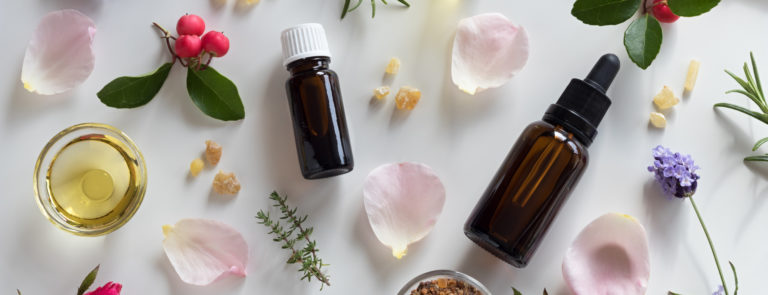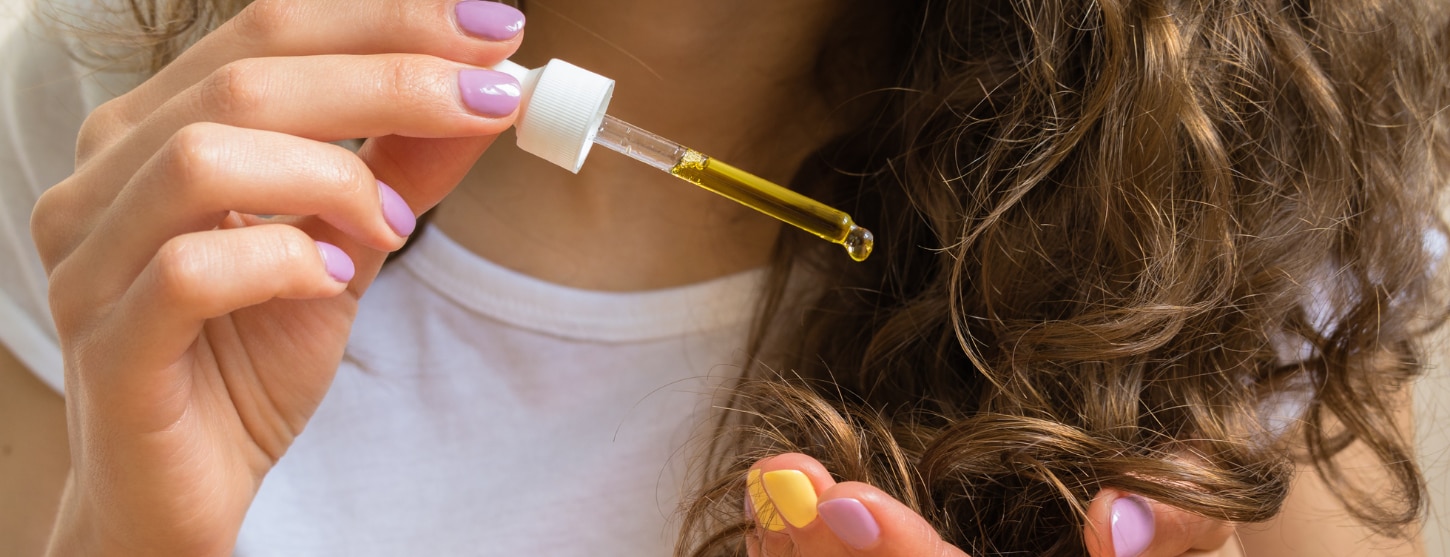20% off €35
10 aromatherapy oils for common skin concerns

Aromatherapy oils are more than just a calming scent. They also offer a natural solution for common skin concerns, such as blemishes and distressed skin.
With their antibacterial and soothing properties, they can soothe irritated skin and combat flare-ups, and here’s everything you need to know…
What are essential oils?
Essential oils come from compounds found in plants, and by extracting these we can distill these compounds into oils that capture each plant’s unique essence, including its scent and beneficial properties.
Are all oils safe to use on the face or skin?
Essential oils are believed to be safe for use on the face and skin when correctly diluted and used as per the production instructions for use.
However, there have also been some cases where people may experience rashes, headaches, asthma, or allergic reactions.1
As such reactions may be hard to predict, women who are pregnant or breastfeeding are recommended to avoid using essential oils.2
Patch tests are also advised when applying an essential oil for the first time, giving you peace of mind that you won’t have an adverse reaction to an oil before applying it fully.
Here’s how you do a patch test:
- Using unscented soap, wash your forearm.
- Dry your forearm (gently).
- Add a couple drops of diluted essential oil to your forearm.
- Rub into a small area on your forearm.
- Keep an eye on this area over the next 24 hours.
If you have any sort of reaction, such as a rash, or itchy, red skin, do not apply this essential oil to further areas. No reaction? You’re likely good to go!
How to use essential oils for skin
-
Complete a patch test
Conduct a patch test before applying any essential oils you haven’t used before. This is an important step to confirm that your skin won’t have a negative reaction.
-
Dilute your chosen essential oil
It is not recommended to use undiluted essential oils on your skin as they can be too concentrated and may cause negative reactions.
Choose a carrier oil—such as coconut oil, jojoba oil, olive oil, or argan oil—to combine with your essential oil, mixing 2% essential oil and 98% carrier oil.
This equates to 12 drops of essential oil to each 30ml of carrier oil, and this should be diluted even further for children or the elderly, aiming for a dilution of 0.5-1% essential oil and 99.5-99% carrier oil.3
-
Apply to your skin
Essential oils are often applied to pressure points on the body, including the chest, the temple, the bottom of your neck, the wrists and ankles, and the bottoms of feet.
If used as part of a massage oil, these could also be applied across more of the body.
Essential oils should never be applied to your ears, nose, or eyes, and should be washed out with warm water if this occurs.
They should also not be consumed as a liquid, as in severe cases, this has proven to have near-fatal effects.4
Summary
- Essential oils are extracted from plants and capture their natural scent and properties.
- Most people can use essential oils, but patch tests are recommended as some people may experience reactions.
- For effective essential oil usage, conduct a patch test, dilute with a carrier oil, and apply to pressure points on the body.
- Essential oils should not be used in the ears, nose, or eyes, and should not be consumed as a liquid.
10 best oils for skin conditions
Wondering which essential oil is best for your particular skin condition? We've got all the info here.
-
Best essential oil for blemishes: Bergamot oil
With its lovely citrus smell, bergamot oil is recognised for its antibacterial properties and can be used to help manage blemishes and pimples due to its soothing properties.
Try it yourself: Mix with a carrier oil, such as olive oil or sweet almond oil, and apply straight to the affected area.
-
Best essential oil for dry skin: Chamomile oil
This gentle aromatherapy oil is great for spots on sensitive skin, while the Roman Chamomile version is useful for easing dry skin concerns.
As it helps skin retain moisture, chamomile oil also helps with dry skin.
Try it yourself: Add two drops of chamomile oil and lavender oil into a spray bottle of purified water and spritz over dry or irritated skin.
-
Best essential oil for fighting bacteria: Cinnamon oil
Cinnamon oil is an incredible essential oil for fighting bacteria.5
It contains a powerful compound called cinnamaldehyde (unique to cinnamon) which makes it effective against a wide range of skin conditions, including rashes and other related skin concerns.
Try it yourself: Mix cinnamon oil with a carrier oil, such as coconut oil, and apply to the skin to soothe the affected area.
-
Best essential oil for itchy skin: Clove Bud oil
Studies have found that clove bud oil may significantly reduce itching.6 In addition to helping alleviate itchy skin, it’s useful for clearing the senses.
Try it yourself: Add two drops of clove bud oil to your skincare products to support the healing process and reduce itchiness.
-
Best essential oil for bruises: Eucalyptus oil.
Eucalyptus oil is often used for first-aid due to its healing properties, treating cuts, bruises and minor wounds.
It’s also effective at relieving acne and chicken pox, boils, wounds, and insect bites.
Try it yourself: Mix with an equivalent amount of apple cider vinegar and dab onto affected areas.
-
Best essential oil for healthy ageing face wrinkles: Lavender oil.
Plus, the best essential oil for managing scars!
Lavender oil, whilst renowned for its calming aroma, is also full of toxin-removing anti-oxidants that fight the oxidative stress related to aging skin.7
Add a touch of lavender oil to your skincare routine for glowing skin. These same skin-repairing properties also mean that lavender oil may support the healing of scars.8
Try it yourself: Mix lavender oil with coconut oil and apply to your face to promote healthy skin or apply to the target area to hasten the healing process.
-
Best essential oil for anti-fungal properties: Lemongrass oil.
Lemongrass is a gentler and sweeter oil than pure lemon, and it works well as an antibacterial essential oil.
It can inhibit the growth of bacteria on the skin, and studies have shown that it may help to improve or prevent fungal conditions such as athlete’s foot.9
Try it yourself: Blend with your favourite bath products or add it to warm bath water to reduce fungal infections such as athlete’s foot.
-
Best essential oil for skin repair: Oregano oil.
Oregano oil is a useful oil for managing skin repair but it’s very strong so you will need to use a carrier oil alongside it.
Try coconut oil or sweet almond oil as a base. This mixture can then be used to combat bacteria on the skin or to promote the natural healing of minor wounds, promoting all-natural skin repair.
Try it yourself: Treat athlete’s foot by adding five drops of oregano oil into a foot bath and bathing your feet for at least ten minutes.
-
Best essential oil for fresh breath: Peppermint oil.
Peppermint is used as a freshening ingredient in dental care products, giving you that minty fresh breath.
However, it’s also good for overall skincare due to its strong anti-bacterial, anti-fungal, and anti-viral properties.
Try it yourself: Soothe cracked lips by applying lip balms containing peppermint oil to the affected area.
-
Best essential oil for sensitive skin: Tea Tree oil.
Tea Tree is one of the most popular aromatherapy oils for managing skin problems.
You can add it to bathwater, skin toners, or facial spritz. Try mixing it with coconut oil or aloe vera gel for an all-natural approach to soothing and treating troubled skin.
It can be used on the face, body, and scalp—a truly head-to-toe aromatherapy oil.
Try it yourself: Make a face wash by mixing five drops of tea tree oil with carriers such as aloe vera gel, coconut oil and lavender oil, before applying gently to the skin.
Handpicked content: The best essential oils for beautiful skin and hair
Summary
- Bergamot oil: Good for reducing redness from blemishes.
- Chamomile oil: Good for relieving the discomfort of eczema.
- Cinnamon oil: Good for fighting bacteria.
- Clove bud oil: Good for reducing itchy skin.
- Eucalyptus oil: Good for supporting the natural healing of bruises.
- Lavender oil: Good for promoting healthy ageing of the skin.
- Lemongrass oil: Good for anti-fungal properties.
- Oregano oil: Good for skin natural skin repair.
- Peppermint oil: Good for minty breath and anti-bacterial properties.
- Tea tree oil: Good for sensitive skin.
9 side effects of essential oil
-
Allergic reactions
Essential oils each have individual compounds and properties and can cause allergic reactions in certain individuals.11 A patch test is always advised when applying any essential oils for the first time.
-
May cause rashes
Certain essential oils, such as peppermint oil, may cause rashes when applied directly to the skin, although few studies have been conducted into why this might happen.12
-
Ingesting may cause serious side effects
Although it is safe to ingest certain essential oils, ingesting large amounts—or oils that are toxic to ingest—may cause serious side effects, such as restlessness, vomiting, vertigo, rapid heart rate, tremors, seizures, and kidney damage.13
-
Topical application may irritate the skin
Applying a large amount of oil—such as tea tree oil—topically across your skin may cause irritation, including rashes or dermatitis.14
Minimal studies into the cause behind this have been conducted.
-
May increase the risk of sunburn
Citrus-based oils, such as lemon, lime, grapefruit, bergamot, and tangerine, may increase your skin’s photosensitivity, meaning your risk of sunburn is also increased.15
This is because these essential oils support the absorption rate of ultraviolet light,16 so it’s recommended to avoid being in direct sunlight for 24 hours after applying.
-
Inhaling essential oils has its own side effects
Although many believe essential oil diffusers are associated with minimal side effects, inhaling large quantities may cause headaches, burning of eyes and throat, nausea, a cough, or shortness of breath.
-
Certain oils should be avoided by pregnant women
Due to the varying compounds and effects of essential oils and the minimal studies into fully understanding how these affect the body, there is a long list of oils that pregnant or breastfeeding women are advised to avoid:
- Aniseed
- Basil
- Birch
- Camphor
- Hyssop
- Mugwort
- Oak mass
- Parsley
- Pennyroyal
- Rue
- Sage
- Tansy
- Tarragon
- Thuja
- Wintergreen
- Wormwood
-
In rare cases, ingestion may be near-fatal
Ingesting essential oils is only advised with recommendations from your doctor or as an FDA-approved ingredient in food.
In one case, ingesting a large quantity of peppermint oil had severe side effects.17
-
Keep away from children and pets.
Due to the side effects mentioned above, and the increased sensitivity of children and pets’ skin and stomachs, essential oils should be locked out of sight.
Summary
- Studies show that some people experience allergic reactions, so patch tests are advised.
- Depending on the oil and individual, oils may cause skin rashes or irritation.
- Ingesting large quantities of essential oils may restlessness, vomiting, vertigo and more.
- Applying all over the body may cause irritation or dermatitis.
- Citrus-based essential oils may increase your risk of sunburn.
- Essential oil diffusers may also cause headaches, burning eyes, nausea, and more.
- Pregnant or breastfeeding women should avoid certain essential oils.
- Only ingest essential oils in FDA-approved foods and by doctor recommendation.
- Lock essential oils away from children and pets.
Essential oils: The summary
There you have it! All the essential information on aromatherapy essential oils, from 10 essential oils for common skin conditions to 9 side effects worth keeping in mind.
As long as you’re careful and use tested, recommended essential oils, there are a number of benefits for mind and body.
Want to diffuse your day with more information on essential oils?
Read “7 most popular essential oils,” “The power of aroma for your wellbeing,” and “The benefits of cinnamon essential oil.”
Last updated: 23 August 2021
- https://pubmed.ncbi.nlm.nih.gov/16243420/
- https://pubmed.ncbi.nlm.nih.gov/11950176/
- https://www.aromaweb.com/articles/dilutingessentialoils.asp
- https://www.ncbi.nlm.nih.gov/pmc/articles/PMC3546250/
- https://www.ncbi.nlm.nih.gov/pmc/articles/PMC4003790/
- https://pubmed.ncbi.nlm.nih.gov/28382655/
- https://www.ncbi.nlm.nih.gov/pubmed/26159138
- https://pubmed.ncbi.nlm.nih.gov/27769632/
- https://onlinelibrary.wiley.com/doi/abs/10.1002/%28SICI%291099-1573%28199611%2910%3A7%3C551%3A%3AAID-PTR1908%3E3.0.CO%3B2-Q
- https://link.springer.com/chapter/10.1007%2F978-94-009-5137-2_26
- https://www.nccih.nih.gov/health/peppermint-oil
- https://www.nccih.nih.gov/health/sage
- https://www.nccih.nih.gov/health/tea-tree-oil
- https://naha.org/explore-aromatherapy/safety
- https://achs.edu/blog/2018/01/30/what-is-photosensitivity-with-essential-oils/
- https://www.ncbi.nlm.nih.gov/pmc/articles/PMC3546250/



